|
Our place in the clouds
After three weeks
in the paradisiacal Costa Rican landscape,
students take to heart the local greeting, "Pura vida." (pure life).

By Nancy Allison
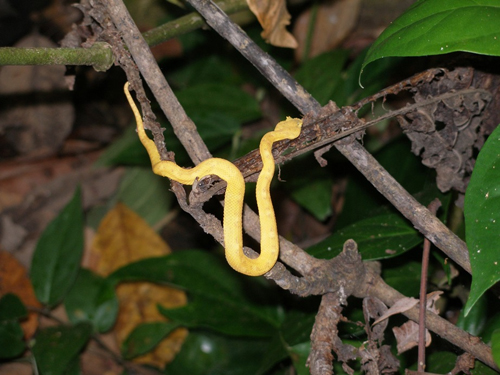 Not long after Chris Moret spots the deadly Bothriechis schlegelii (or yellow eyelash pit viper, which is the color of lemon pie), Charlotte Owens is bitten by fire ants on her badly strained toe, Abby Schlipmann nearly faints in the tropical heat, and Stephanie Jones gets into a tussle with a pilfering monkey. So how come they're all still smiling? Not long after Chris Moret spots the deadly Bothriechis schlegelii (or yellow eyelash pit viper, which is the color of lemon pie), Charlotte Owens is bitten by fire ants on her badly strained toe, Abby Schlipmann nearly faints in the tropical heat, and Stephanie Jones gets into a tussle with a pilfering monkey. So how come they're all still smiling?
It may sound like a segment of "Survivor," but it's all in a day's hike for the 14 students on May's environmental stewardship trip to Costa Rica. Other mornings they swam in the Pacific or zip-lined through rainforest canopy, but today's six-kilometer trek in Cahuita National Park is their last chance before leaving to sight some of the most amazing plants and animals in the world.
During nearly three weeks of lectures, tours and traveling, they've seen a huge chunk of this tropical country bordering Panama and Nicaragua. Somewhere between the volcanoes, cloud forests, coral reefs, waterfalls, rivers and lush green hills, they've been getting an education.
Press them a bit and they'll admit that they're tired. Yet, despite the dive-bombing mosquitoes and torrid temps of the Caribbean coast in late May, this mixed group of environmental science, education, design, communication and film students can't help it. They're still buzzed.
Moret and fellow environmental science graduate student Tyler Smith couldn't wait until this morning to get started: late last night they scouted the trails behind their eco lodge, surprising poison dart frogs, a sleepy caiman and leaf cutter ants -- those Schwarzeneggers of the insect world that can tote up to 20 times their body weight. "It was like a superhighway of leaf cutters: six inches wide!" Smith says with obvious delight.
 "There's no way you can be blasé about the wildlife here, even if you're not a science person," says Jones, a graduate student in communication studies who was undaunted by the monkey who tried to steal her backpack. And if you are a science person, Costa Rica "is one of the best places in the world for field study," says environmental studies grad student Jeff Swofford.At just 0.01 percent of the world's landmass, Costa Rica holds 5 percent of all the known species on Earth. Sloths, monkeys, snakes, iguanas, birds the colors of flowers and flowers that resemble birds are just a few of the reasons why there's a long waiting list for the three-week study abroad trip every year. "There's no way you can be blasé about the wildlife here, even if you're not a science person," says Jones, a graduate student in communication studies who was undaunted by the monkey who tried to steal her backpack. And if you are a science person, Costa Rica "is one of the best places in the world for field study," says environmental studies grad student Jeff Swofford.At just 0.01 percent of the world's landmass, Costa Rica holds 5 percent of all the known species on Earth. Sloths, monkeys, snakes, iguanas, birds the colors of flowers and flowers that resemble birds are just a few of the reasons why there's a long waiting list for the three-week study abroad trip every year.
Another factor is undoubtedly Gustavo Abarca, the Costa Rican naturalist and guide who arranges everything from volcano tours to river rafting for the students. An expert on the history, flora and fauna of his country, and fluent in three languages, Abarca, an employee of the world-renowned Lindblad Expeditions, has led tours for Stanford, National Geographic Society and MIT.
"We wouldn't -- we couldn't -- do the trip without Gustavo," says TCU's Institute of Environmental Studies Director Mike Slattery, who has worked with Abarca since the Costa Rica program began in 2002.
"Gustavo is the Jedi of guides," says environmental science grad student Stephanie Corso. "He keeps us so engaged. We'll be driving along and he'll just point and say ‘toucan.' Or we'll be walking and he'll hear a bird and can tell exactly what it is by the call. He knows what it eats, if it's endangered. He probably knows its mating dance too."
Corso credits Abarca with providing one of her favorite moments of the trip: sighting a resplendent quetzal. Considered divine by the pre-Columbian civilizations, the quetzal is as well known for being hard to find as it is for its emerald breast and fantastically long tail feathers.
Fellow graduate student in environmental science Morgan Dezendorf was with Corso when they heard two quetzals call. "But we couldn't see them," says Dezendorf. "We were freaking out trying to find them. And then Gustavo came around the bend of the trail and pointed. They were on a branch right on top of us."
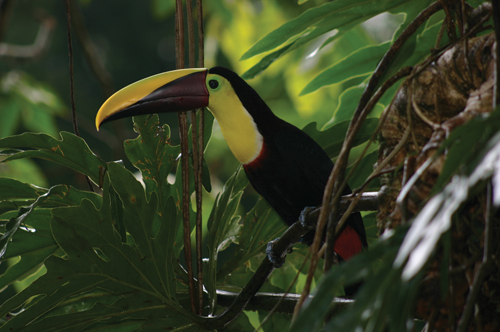 When he's not locating elusive animals or locking them in on his scope so that the group can examine them up close, Abarca describes the vagaries of the cocoa tree (it fruits directly from the bark) or the tensile strength (stronger than Kevlar) of the golden orb weaver spiders' web. He also gives good practical advice. On the way into Cahuita, Tyler Smith spied a family of howler monkeys climbing in the treetops. The entire TCU group congregated under the branches to see. When he's not locating elusive animals or locking them in on his scope so that the group can examine them up close, Abarca describes the vagaries of the cocoa tree (it fruits directly from the bark) or the tensile strength (stronger than Kevlar) of the golden orb weaver spiders' web. He also gives good practical advice. On the way into Cahuita, Tyler Smith spied a family of howler monkeys climbing in the treetops. The entire TCU group congregated under the branches to see.
Keeping her eyes on the humans, a wary female moved through the leaves with two coal-black babies on her back. Several minutes later, Abarca's matter of fact voice cut through the excited whispers: "Look out guys, she's getting ready to poop." Everyone scattered just in time, and sure enough, a few seconds later mama monkey let fly, her twin passengers wide-eyed at the hubbub down below.
Abarca is also an expert on the geography and history of Costa Rica, its plenitude of conservation programs, and the problems it still faces. During the drives across country, he uses the landscape as a teaching tool, reinforcing lectures by professors from the University of Costa Rica. Noemi Barquero's discussion of Costa Rican agriculture and Edwin Canessa's talk on biodiversity literally came to life along the national highway when Abarca drew the group's attention to the acres of spiky fields passing by the window. Many students had already noticed that the landscape was starkly different from the usual forested tangle of ferns, succulents, and fruiting, flowering trees. Here, there were only pineapple plants. Miles of them.
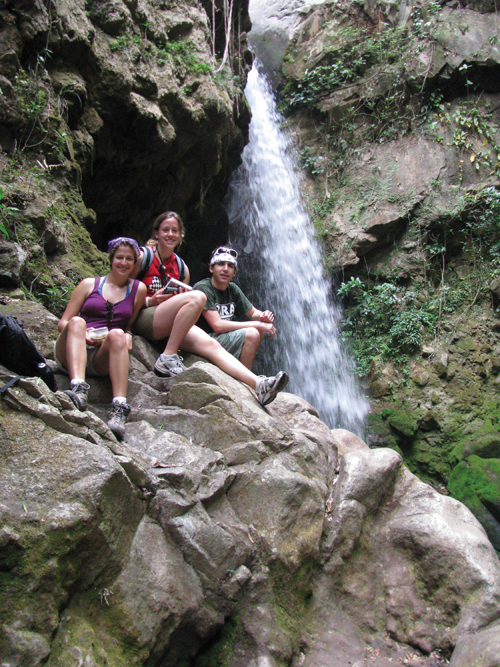 Fresh pineapple is now Costa Rica's number one export, after bananas. Both of these crops thrive thanks to massive amounts of insecticides and herbicides. They replace a habitat that formerly supported thousands of plant and animal species. To be specific: In only 1,000 hectares (four square miles), tropical rainforests hold up to 1,500 species of flowering plants, 750 species of trees, 125 species of mammals, 400 species of birds, 150 species of butterflies, 100 species of reptiles, and 60 species of amphibians. What better way for the students to grasp what is lost by rainforest destruction than to see firsthand the contrast between orchid-draped forest and these endless fields? Fresh pineapple is now Costa Rica's number one export, after bananas. Both of these crops thrive thanks to massive amounts of insecticides and herbicides. They replace a habitat that formerly supported thousands of plant and animal species. To be specific: In only 1,000 hectares (four square miles), tropical rainforests hold up to 1,500 species of flowering plants, 750 species of trees, 125 species of mammals, 400 species of birds, 150 species of butterflies, 100 species of reptiles, and 60 species of amphibians. What better way for the students to grasp what is lost by rainforest destruction than to see firsthand the contrast between orchid-draped forest and these endless fields?
From the beginning, the study abroad course has woven science into sightseeing. A day spent horsing around in the Pacific follows a lesson on coastal and marine ecology. A trip to see the active Arenal volcano dovetails with a lecture on the geologic evolution of Costa Rica. And a tour of a coffee co-op near San Jose introduces an examination of land degradation and sustainable agriculture.
The goal is to foster in the students, "an understanding of what it means in a country blessed with such incredible resources to struggle to protect and preserve those resources, while trying at the same time to develop responsibly," Slattery maintains. It's something that Costa Rica is known for trying to do well, in part to compensate for rampant deforestation. Now, although still under threat from the increase of pineapple farms, nearly 25 percent of its land is devoted to national parks or reserves.
Abarca makes it personal by introducing the students to local people with a passion for conservation. Men like Julio Fernandez Amon, who, after a career in education, trained as a chocolatier. With partner George Soriano, he formed Sibu, a company committed to using only organic Costa Rican cocoa and milk products for their chocolate. The pair's enthusiasm for protecting the environment while still following their dreams impressed the students greatly.
"It's chocolate, so of course it's wonderful," said one student, sampling a truffle. "But this is like, save-the-world chocolate!"
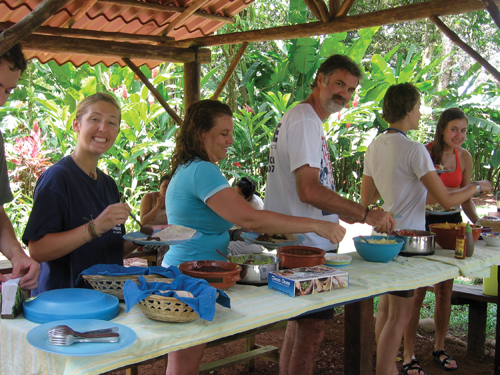
Discovering hidden passions
Conservation depends on people and their passions, and especially on the choices they make. Seeing people like Amón and Soriano encourages the students to think about their own lives, their own choices. After the pineapple fields, someone was overheard sighing, "I'll never eat pineapple again."
And after the trip to the chocolate factory: "I don't know what I want to do with my life yet, but I know that when I find it, I want to be as passionate about it as Julio is!"
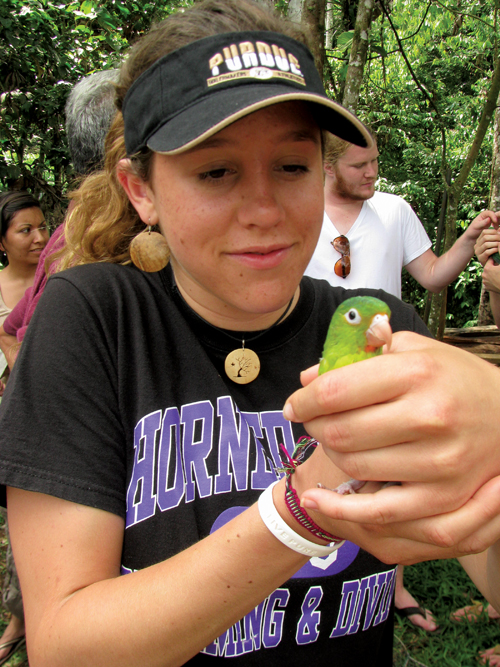 For environmental science sophomore Macy Zander, the power of Costa Rica lies in the discovery that people can make a difference. "It's hard to describe the sense of hope this trip has given me, from meeting people here who are taking sustainable alternatives to everyday living and creating eco lodges, parks and sanctuaries without any government funding whatsoever. For environmental science sophomore Macy Zander, the power of Costa Rica lies in the discovery that people can make a difference. "It's hard to describe the sense of hope this trip has given me, from meeting people here who are taking sustainable alternatives to everyday living and creating eco lodges, parks and sanctuaries without any government funding whatsoever.
"The coffee plantation, the organic chocolate farm, the largest cloud forest preserve in Central America -- they're all private. In the U.S. we put too much dependence on government. We underestimate the power that grass roots-bred initiatives have."
But this group doesn't. At least not now. Grass roots experiments have already begun. By the time the first week is over, there's competition to see who can take the shortest shower or keep a water bottle the entire trip, refilling it rather than buying new. When asked if they think the habits will last after they get home, everyone says yes. Something unexpected has happened to them.
"There's something about this place that allows you to feel a deeper connection with the world around you," says Jones. "La Fortuna [a 70-meter waterfall] was the most powerful thing I've ever seen. Usually we feel so big: we have our cars, TVs, pools, computers; but who are we really in the grand scheme of things?"
For Jones, it was a thundering cascade of water. For Preston Culver, RTVF sophomore, it's the wildlife. Culver has always loved animals and watching programs about them, but it just didn't click until he came on the trip. He's pursuing documentary filmmaking at TCU, and since coming to Costa Rica has decided that, "making films about animals is the best way I can think of to get people to care about their survival."
Environmental science junior Warren Lord is so entranced by the plant and animal life here that he plunks himself down closer than seems prudent to sketch the eyelash pit viper or poisonous dart frog. He's always the last one to emerge from a walking trail, as if he finds it difficult to tear himself away from the forest and all its mysteries.
These students "get it," says professor of professional practice Becky Richards, who has been coming to Costa Rica with TCU since 2006. "This course is life altering for so many students. They forget about their iPods and so-and-so's party and discover something far more real here. I feel privileged to see that every time I come. That's the moment you live for as a teacher, to see that light bulb go on."

Jungle outpost
Transformation seems to be a recurring theme of the annual trip. The most enduring "Aha!" moment for TCU in Costa Rica came in 2006, after a day spent at the farm of Gustavo Orozco, a nationally known conservationist and guide. Orozco was constructing the infrastructure for a scientific research facility on his 300-acre farm in the cloud forest. It was self-funded and taking a long time to complete -- he had been working on it for 15 years already. His hope was to establish a relationship with an organization or university to preserve huge sections of the forest intact, and develop a scientific research station that would benefit his country.
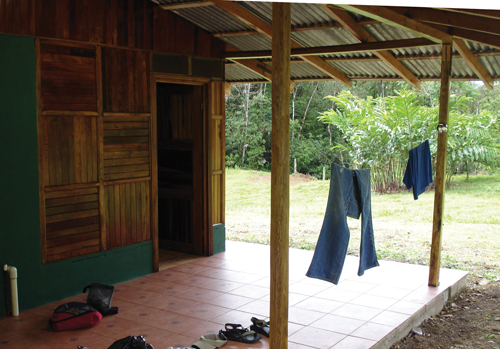 The TCU group that year was mostly comprised of environmental science majors and graduate students eager to do something transformative for Costa Rica, to leave something behind. The evening after meeting Orozco, Slattery called his students together. Did they really want to leave a legacy? The TCU group that year was mostly comprised of environmental science majors and graduate students eager to do something transformative for Costa Rica, to leave something behind. The evening after meeting Orozco, Slattery called his students together. Did they really want to leave a legacy?
"It was the year that the Vision In Action challenge grants got started. So I challenged them to write a VIA proposal for a permanent biological research station on Orozco's property at San Ramon."
The students jumped at the chance. Richards, an experienced program manager, volunteered to oversee the process if the students were serious and did the work.
They were and they did. It took eight students five months to write the $130,000 grant proposal for the San Ramon Tropical Research Station.
How could the committee turn it down? The chance to conduct long-term studies in such a biologically significant area (adjacent to the largest private cloud forest preserve in Central America) would give students and professors the opportunity to make real strides in biological and ecological research. It would raise TCU's profile, aligning it with institutions such as Harvard and Cornell, known for their enduring presence at remote field sites.
But the distinguishing feature of the station would be its dedication to educating and assisting the local community. This would mean a decidedly interdisciplinary bent: courses associated with programs as diverse as nursing, business, sociology, and education, would all be welcome at the San Ramon Tropical Research Station. The mission for the station would coincide with the VIA mission: to connect TCU to the rest of the world. And by doing so, help protect the rich resources of a country under tremendous pressure to develop and change.
They got the grant.
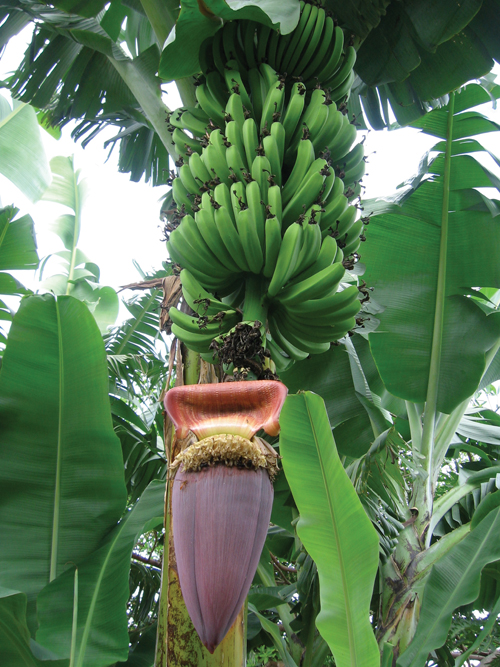 In January 2008, work began on TCU's outpost in the tropics. The sound of men working has rung for months through the misty forest, competing with the cawing birds, the howling monkeys, and the drumming rain. Two bungalows for faculty, a main building with space for up to 20 students, a library and two lookout towers thrusting into the tree canopy are now complete and ready for use. In January 2008, work began on TCU's outpost in the tropics. The sound of men working has rung for months through the misty forest, competing with the cawing birds, the howling monkeys, and the drumming rain. Two bungalows for faculty, a main building with space for up to 20 students, a library and two lookout towers thrusting into the tree canopy are now complete and ready for use.
When last summer's students toiled up the trail to the San Ramon property, they were bushed. The trip had taken hours of driving until the turnoff, then hours more on an unpaved road. And then they had to walk at least another mile. But good things come to those who wait: San Ramon is in an area famous for its cloud forest, where the elevation and rainfall contribute to a staggering number of plant, animal and insect species, many yet to be identified and studied. Aside from that, it is breathtakingly beautiful: a paradise of trees.
Charlotte Owens was talking, as usual. She wasn't really sure why she felt so strongly about coming to Costa Rica. At age 40, Owens is in the third year of an undergraduate interior design degree, creating her own major in sustainable design. Arranging to leave three kids at home for 16 days was no piece of cake. Yet somehow she knew she had to come.
Owens is a whirlwind of a woman, always thinking, questioning and communicating. But when she saw TCU's foothold in the forest: two rustic cabins and all the lumber needed to build, "a totally sustainable research station perfectly suited to its environment," she did something totally out of character. She didn't say a word.
"I was blind sided. I nearly fell over in tears," she recalled. Looking at the nascent structure, imagining the dozens of students it would house over the coming years and the impact that their research would have, she had an epiphany.
"I realized I could marry my passion -- designing sustainable structures for living -- with doing the right thing. This trip is not just for people in the sciences, nor is the station. It's about the whole human endeavor: How will you live your life, in terms of protecting the planet? At San Ramon, I found my answer."
The first two environmental studies grad students to make use of the San Ramon facility, Abby Schlipmann and Morgan Dezendorf, have begun to find answers, too. The two waved goodbye to their fellow students in May, then spent six weeks in one of the finished bungalows at San Ramon without electricity or internet access, conducting research for their master's theses.
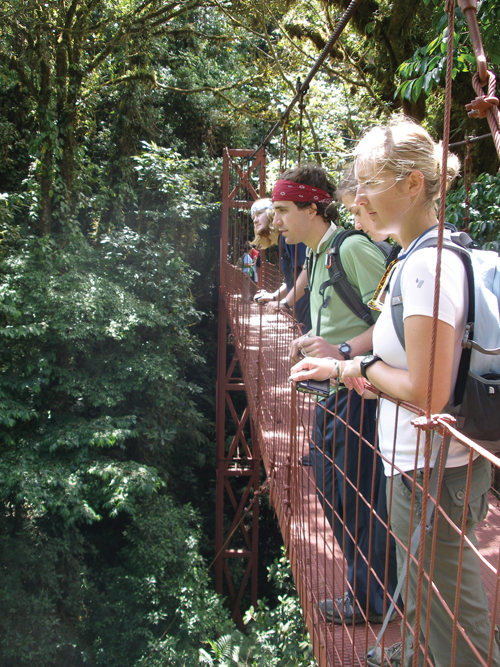 They helped each other in their work, surviving a couple of "snake incidents" and enjoying the incredible views and the dawn to dusk schedule. They helped each other in their work, surviving a couple of "snake incidents" and enjoying the incredible views and the dawn to dusk schedule.
"We'd wake up with the sun and do all our hard work in the morning. During the torrential downpours in the afternoon, we would read or write." They'd read by lantern for a bit after supper, but by 8 p.m. were in bed.
Dezendorf is researching the effects of eco tourism in the area. She's conducted hours of interviews with business owners and artists in the touristic region of Monteverde.
"It's very much a community all committed to the same ideals."
Dezendorf has begun delving into the sense of place in her thesis.
"I am more accustomed to plotting graphs than writing an interview-based paper, so I've been very glad that [sociology instructor] Keith Whitworth has been so willing to share his knowledge of qualitative research."
Schlipmann is studying the station's water supply and monitoring its natural treatment system. With a GPS and Dezendorf's help, she mapped all of the streams on the property this summer, and will work on creating tilapia ponds and an irrigation system for the garden. In time, she hopes to expand her investigation of water quality to other parts of the country. "Only 3 percent of the wastewater in Costa Rica is treated," she says. "This causes infections and illness, especially in children in rural areas. I'd like to change that."
Looking forward
 Things tend to grow quickly in the tropics. But Slattery seems surprised that in just six years his study abroad seedling has grown into such a hefty tree. He is convinced that San Ramon is "potentially so transformative" (there's that word again) to TCU programs that it should be made part of the university's operational budget when the VIA grant expires in 2011. Things tend to grow quickly in the tropics. But Slattery seems surprised that in just six years his study abroad seedling has grown into such a hefty tree. He is convinced that San Ramon is "potentially so transformative" (there's that word again) to TCU programs that it should be made part of the university's operational budget when the VIA grant expires in 2011.
On the night before leaving Costa Rica, at a reggae restaurant in the coastal town of Puerto Viejo de Salamanca, Gustavo "Jedi" Abarca helps to organize everyone's order, translating if necessary. He recommends the ripe plantains and the guanabana juice for starters, and isn't fazed when a crab walks in from the beach. When Tyler Smith comes to the rescue, braves the crab's claws and lifts it by a swimmer to take it back down to the sea, Abarca gives him the thumbs up.
Maybe he's relieved that he doesn't have to name the species, just this once. Abarca has been engaged and engaging since 6 this morning. When asked if he's glad the trip is nearly over, he smiles. "I only do this kind of a long trip for TCU. I feel really lucky to work with Dr. Slattery, and I believe we are making a good positive impact. TCU students show great respect for our culture, our national parks and our main passion: protection of the environment. We're glad to have them here."
More information:
www.ensc.tcu.edu.

Comment at tcumagazine@tcu.edu. |



